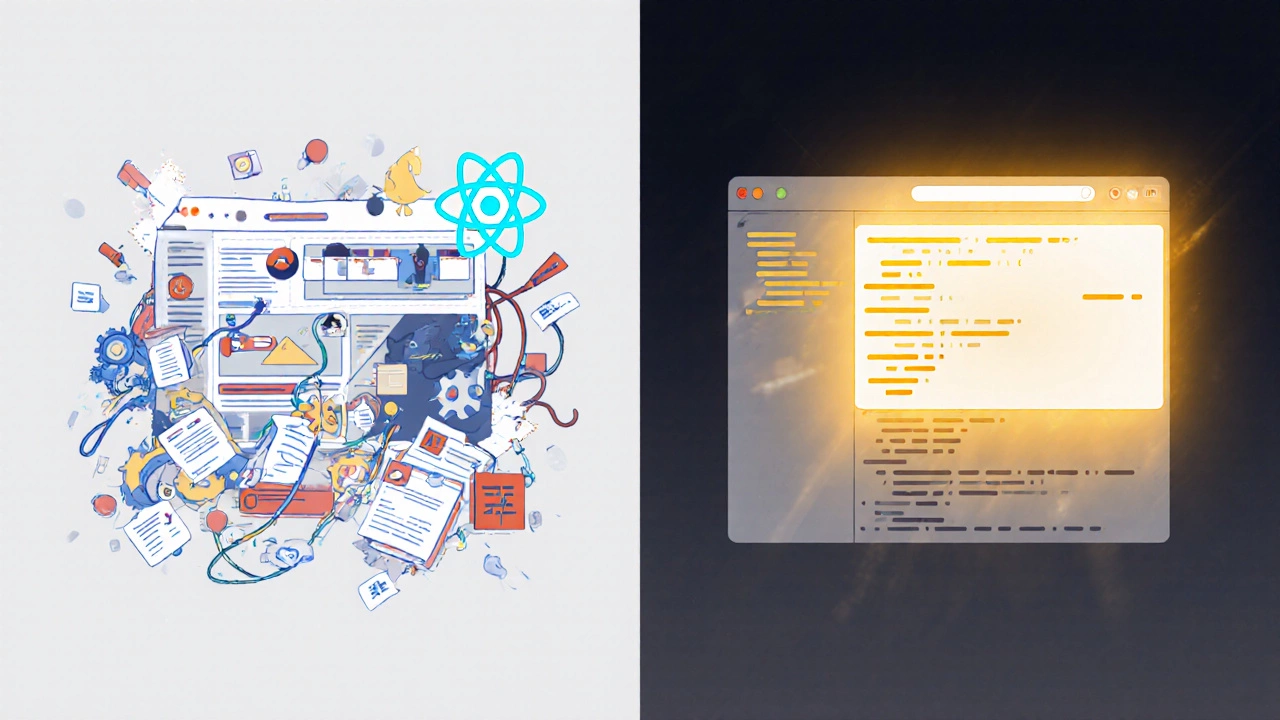React Learning Time Calculator
Your estimated time to learn React basics: N/A
Based on article's estimate: 2-4 weeks with consistent practice (50-100 hours total)
When you ask what framework most developers are using in 2024, the answer isn’t a mystery-it’s React. Not because it’s the newest, not because it’s the flashiest, but because it just works, everywhere, for everyone. From tiny startups in Bangalore to Fortune 500 companies in New York, React powers the frontends of millions of websites and apps. If you’ve visited any modern website in the last five years, chances are React was behind it.
Why React dominates in 2024
React isn’t just popular-it’s the default choice for new projects. In the 2024 Stack Overflow Developer Survey, over 40% of professional frontend developers said they used React regularly. That’s more than double the next closest framework. Why? Because React solves real problems in a simple way.
Before React, building dynamic web apps meant writing messy JavaScript that directly manipulated HTML. Every button click, form update, or data load required manual DOM changes. It was slow, error-prone, and hard to scale. React changed that by introducing the virtual DOM. Instead of rewriting the whole page, React figures out exactly what changed and updates only that part. It’s like using a highlighter to mark only the sentences you need to edit, instead of rewriting the whole paragraph.
React also lets you build reusable components. A button, a navigation bar, a product card-you write it once, then use it anywhere. That’s why companies like Facebook, Airbnb, and Netflix stuck with React. They don’t need to rebuild the same UI elements over and over. They just plug them in.
How React compares to other frameworks
It’s fair to ask: what about Vue? Or Angular? Or Svelte? All of them have their strengths, but none match React’s ecosystem and adoption.
Angular is powerful but heavy. It’s a full framework with built-in tools for routing, state management, and forms. That sounds great-until you realize you’re loading 100KB of JavaScript just to show a simple form. For mobile users or slow connections, that’s a dealbreaker.
Vue is lightweight and easy to learn. Many beginners start with Vue because it feels intuitive. But Vue’s community and job market are smaller. If you’re looking for freelance gigs or a job in a big company, React opens more doors.
Svelte is exciting. It compiles components into ultra-efficient vanilla JavaScript at build time. No virtual DOM. No runtime overhead. But Svelte’s ecosystem is still growing. Libraries, tools, and third-party integrations are limited compared to React’s massive library of plugins and packages.
React doesn’t have the cleanest syntax. It uses JSX, which mixes HTML and JavaScript. Some developers hate it at first. But once you get used to it, you realize it’s not a flaw-it’s a feature. JSX lets you write UI logic right next to the markup it controls. That makes debugging and maintaining code way easier.
What’s driving React’s growth in 2024
React’s dominance isn’t accidental. Three big trends pushed it to the top:
- Mobile-first development: More than 60% of web traffic now comes from phones. React Native lets developers build native iOS and Android apps using the same React skills. Companies don’t need two separate teams-one for web, one for mobile. One team does both.
- Developer tooling: Tools like Vite, Next.js, and React DevTools make building with React faster than ever. Next.js, in particular, has become the go-to for server-side rendering and static site generation. It handles SEO, performance, and routing out of the box. Many new projects start with
create-next-appinstead of plain React. - Job market demand: If you search for frontend developer roles in India, the U.S., or Europe, React appears in 80% of job postings. Companies aren’t just hiring React devs-they’re training existing teams in React. It’s the language of modern web work.

Who uses React in 2024?
You don’t have to take my word for it. Look at the real world:
- Facebook and Instagram still run on React. They built their entire mobile apps using React Native.
- Uber’s web dashboard uses React to manage thousands of real-time ride updates.
- PayPal redesigned its checkout flow with React and saw a 30% drop in cart abandonment.
- Even government websites in India, like the Ayushman Bharat portal, switched to React for faster load times and better accessibility.
It’s not just tech giants. Small businesses in Bangalore, Pune, and Jaipur are using React to build affordable, scalable websites. With tools like Vercel and Netlify, you can deploy a React site for free in under five minutes. No servers. No complex setup. Just code and deploy.
Is React perfect?
No. It’s not.
React itself is just a library for building UIs. You still need to choose state management tools-Redux, Zustand, Context API-and routing libraries-React Router. That freedom is great for experts but overwhelming for beginners. Some people call it the “JavaScript fatigue” problem: too many choices, too many tools.
But that’s changing. Next.js now handles routing, state, and server-side rendering out of the box. React Server Components, introduced in 2023, let you render components on the server without sending them to the client. That means faster pages and less JavaScript for users. React is evolving, not stagnating.

What should you learn in 2024?
If you’re starting out in web development, learn React. Not because it’s trendy, but because it’s the foundation of modern web work.
Start with the basics: components, props, state, and hooks like useState and useEffect. Then move to Next.js. It’s the easiest way to build real projects fast. Build a personal portfolio site. Build a todo app that saves to localStorage. Build a weather app that fetches data from an API. These aren’t just exercises-they’re your first portfolio pieces.
Once you’re comfortable, explore React Native if you’re interested in mobile apps. Or learn TypeScript to make your React code more reliable. These are natural next steps.
Don’t waste time learning older frameworks like jQuery or Angular 1.x. They’re still out there, but they’re legacy. Companies aren’t hiring for them. They’re hiring for React, Next.js, and TypeScript.
Final thought: React isn’t going anywhere
Frameworks come and go. Angular was king in 2015. Vue surged in 2020. But React has stayed on top for nearly a decade. Why? Because it’s flexible, performant, and backed by a massive community. Meta (Facebook’s parent company) still invests heavily in it. Millions of developers contribute to it. Every month, new tools, tutorials, and plugins appear.
In 2024, if you want to build websites that people actually use, you need to know React. Not as a hobby. Not as a side skill. As your main tool.
Is React the only framework worth learning in 2024?
No, but it’s the most important. Other frameworks like Vue and Svelte are great for specific use cases, but React has the largest job market, the most learning resources, and the broadest ecosystem. If you learn React, you can easily pick up other frameworks later. Starting with anything else limits your options.
Do I need to learn JavaScript before React?
Yes. React is built on JavaScript, so you need to understand variables, functions, arrays, objects, and ES6+ features like arrow functions and destructuring. You don’t need to be an expert, but you can’t skip the basics. Start with JavaScript fundamentals, then move to React. Most beginners who jump straight into React get stuck because they don’t understand how the underlying language works.
Can React be used for backend development?
No. React is a frontend library only. It runs in the browser and builds user interfaces. For backend development, you need Node.js, Python (Django/Flask), Ruby on Rails, or similar server-side technologies. However, React works closely with backend APIs. You’ll often use React to display data fetched from a backend server.
Is React good for SEO?
Plain React apps can struggle with SEO because they rely on JavaScript to render content. Search engines used to have trouble reading dynamically loaded pages. But tools like Next.js solve this with server-side rendering (SSR) and static site generation (SSG). Most modern React apps built with Next.js rank just as well as traditional HTML sites.
How long does it take to learn React?
You can learn the basics of React in 2-4 weeks with consistent practice. But becoming job-ready takes 3-6 months. That includes building real projects, learning state management, handling API calls, and understanding tools like Git and deployment platforms. Don’t rush it. Focus on building one solid project instead of ten half-finished ones.

